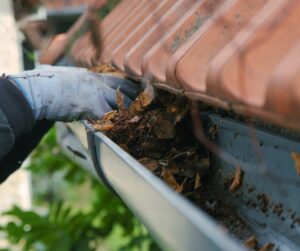As the crisp air rolls into Kansas City and the leaves start turning shades of gold and red, homeowners know what’s next—yards full of fallen leaves and gutters that need attention. Gutters are your home’s first line of defense against water damage, yet they’re often one of the most overlooked parts of fall maintenance. Ignoring them can lead to clogged downspouts, foundation damage, mold growth, and costly repairs down the line.
This fall, take the time to protect your home with a proactive gutter maintenance plan. Here’s a step-by-step guide tailored for Kansas City homeowners.

Why Fall Gutter Maintenance Matters in Kansas City
Kansas City’s climate can be tough on gutters. Autumn brings heavy leaf fall, especially in neighborhoods lined with maples, oaks, and elms. Soon after, winter storms arrive, and clogged gutters can quickly lead to ice dams or overflowing water that seeps into basements. With our mix of rain, snow, and freeze-thaw cycles, gutters that aren’t properly maintained can compromise your home’s siding, foundation, and landscaping.
The good news? A little effort now can prevent major headaches later. Think of this as your seasonal insurance policy.
Step 1: Inspect Your Gutters for Damage
Before you start scooping leaves, take a close look at your gutter system. Walk the perimeter of your home and check for:
- Cracks, rust spots, or holes
- Sagging or pulling away from the roofline
- Separated joints or seams
- Water stains on siding, which may indicate leaks
Pay attention after a rainstorm too—if you notice water spilling over instead of flowing through, there’s likely a clog or slope issue. Spotting these problems early can save you from expensive repairs.
Step 2: Clear Out Leaves and Debris
In Kansas City, where fall leaf drop is heavy, cleaning gutters is a must-do chore. Put on gloves, grab a sturdy ladder, and carefully remove leaves, twigs, and roof grit. Tools like a small trowel or gutter scoop can speed up the job.
Once the big debris is gone, flush the gutters with a garden hose to wash away smaller particles and test for proper flow. This also helps reveal leaks you may have missed during inspection.
Pro Tip: Have someone hold the ladder steady for safety. If heights aren’t your thing, professional gutter cleaning services are worth every penny.

Step 3: Check and Clear Downspouts
Even if your gutters are spotless, blocked downspouts can cause just as much trouble. Run water through each downspout to check for clogs. If the flow is weak or water backs up, try:
- Tapping the downspout with a rubber mallet to loosen debris
- Using a plumber’s snake or high-pressure hose nozzle to push blockages through
- Ensuring downspouts extend at least five feet from your foundation
Pooling water near your foundation is a red flag—consider adding extensions or splash blocks to direct water further away.
Step 4: Confirm Proper Gutter Slope
Gutters need the right slope to carry water toward the downspouts. Too flat, and water will pool; too steep, and it may overflow. The correct pitch is about 1/4 inch of drop for every 10 feet of gutter.
To check yours, place a level along the gutter run. If adjustments are needed, tighten or reposition brackets. While this may sound minor, improper slope is a common culprit of water damage around homes in our region.
Step 5: Test for Leaks and Seal Them
After cleaning and adjusting, run water through your system again to look for leaks. Pay close attention to seams, corners, and joints—these are the most likely places for drips.
Minor leaks can usually be fixed with an outdoor-rated gutter sealant or silicone caulk. Larger gaps may require a patching kit, and extensive damage could mean it’s time for replacement.
Step 6: Watch for Rust, Loose Fasteners, and Wear
Older gutters, especially steel systems, are prone to rust and corrosion. Flaking paint, orange spots, or pinholes are warning signs. Also check fasteners, hangers, and brackets—loose hardware can cause sagging gutters that pull away from your home. Addressing these small issues now prevents larger structural failures later.
Step 7: Trim Overhanging Branches
Trees are a beautiful part of Kansas City neighborhoods, but they’re a gutter’s worst enemy. Overhanging branches drop leaves, twigs, and sometimes whole limbs directly into your system. Trim back branches that hang over your roofline to reduce debris and prevent storm damage.

Step 8: Consider Gutter Guards
If cleaning gutters multiple times each fall feels overwhelming, gutter guards or covers may be worth the investment. While they don’t eliminate maintenance entirely, they drastically reduce the amount of debris entering your gutters, making future cleanings quicker and easier.
For homes in leafy suburbs like Brookside, Waldo, or Liberty, guards can extend the time between cleanings and offer extra peace of mind.
Step 9: Schedule Professional Maintenance
Even the most diligent DIY homeowner can benefit from professional care. Experts have the tools and expertise to handle tricky clogs, adjust slopes, and catch hidden issues. Scheduling a fall inspection ensures your system is ready for winter storms.
Think of it this way: a service call now is far cheaper than repairing a flooded basement or replacing damaged siding.
Seasonal Tips for Kansas City Homeowners
- Plan for twice-yearly cleaning. Once in late spring (after seed pods and pollen drop) and once in late fall (after leaves are down) keeps your system in shape.
- Check after big storms. Midwest thunderstorms often scatter debris that can block gutters overnight.
- Pair gutter care with other fall chores. While you’re sealing driveway cracks, servicing your furnace, and winterizing faucets, add gutters to the list.
By rolling this into your seasonal checklist, you’ll keep your home protected year-round.

Final Thoughts
Fall gutter maintenance isn’t glamorous, but it’s one of the smartest investments you can make in your home. Kansas City weather doesn’t cut homeowners any slack—between leaf drop, heavy rain, and winter ice, gutters need attention to keep water flowing where it belongs.
By inspecting, cleaning, checking slope, sealing leaks, and trimming trees, you’ll save yourself money, protect your home’s foundation, and avoid the stress of water damage. Whether you tackle it yourself or call in the pros, this fall is the perfect time to make gutter maintenance a priority.



